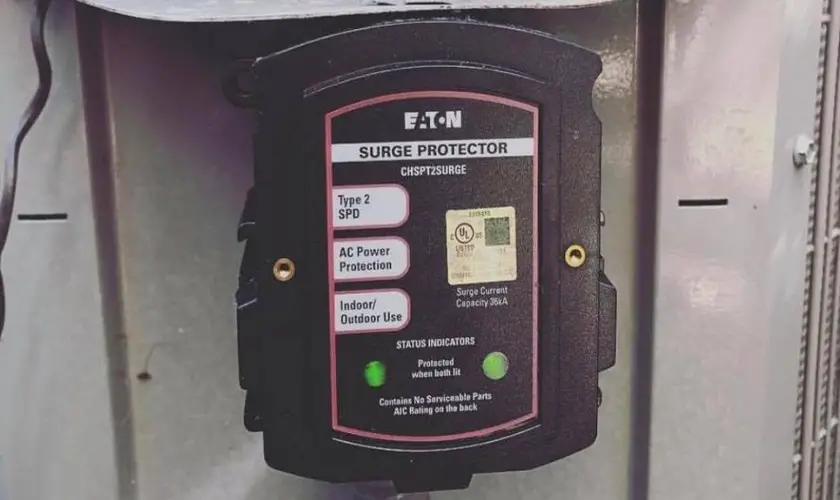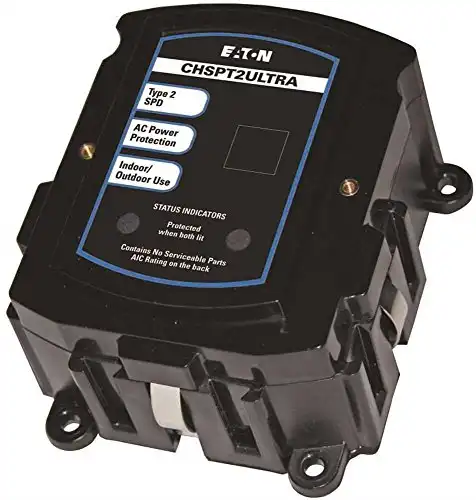
There are pros and cons of whole house surge protectors. A whole-house surge protector is a device installed in your home’s electrical panel, designed to protect all of your appliances and electronics from power surges.
A power surge can occur when there is a spike in electricity, damaging your large appliances or even causing a fire. Whole home surge protection is an excellent way to protect your home investment, but there are also some drawbacks that you should be aware of.
But first, it’s important to understand there are three types of whole house surge protection, and you may need all three to be fully protected.
Types of Surge Protectors
There are three types of surge protectors on the market. When selecting the finest one for your house, you must first identify the surge protection device type.
Type 1 – External Power Surges
Type 1 devices provide the most protection from external sources and low-powered surges. They also defend against low-power surges. These types of surges are seldom dangerous.
Before the main breaker box, surge protectors are placed at the electrical service meter base. Because this is known as the “line side,” only safe amounts of electricity may enter your home.
Installation of Type 1 surge protection requires the home’s power to be switched off. The installation is done by a professional electrician, which can dramatically increase costs.
Type 2 – Internal Power Surges
Type 2 whole house surge protectors (the ones we feature in this article) are the most popular surge protectors. They can be installed inside the main panel or a sub panel. Installing them can be done by anyone who is knowledgeable about DIY and has some electrical experience. However, we recommend calling in a licensed electrician to do the installation for you.
Type 2 surge devices can protect a single circuit or all the circuits in an electrical panel. This is why it is handy to have a knowledgeable electrician.
The National Fire Protection Association (NFPA) has proposed that new homes have a Type 1 or Type 2 device installed. If you are replacing your service panel, it must include one of these devices.
Type 3 – Internal Power Surges
Type 3 point-of-use surge protectors include wall outlet and power strip surge protectors. They are a popular and low-cost way to protect your devices from power surges. It plugs into any household outlet and typically has 4-6 additional outlets. This is a convenient way to protect devices like TVs, computers, or gaming consoles.
These devices are called surge arresters. Surge protectors absorb excess power and can stop most damage. However, they are not 100% effective.
Pros and Cons of Whole House Surge Protectors
There are advantages and disadvantages of whole-house surge protectors. In my opinion, the advantages far outweigh the disadvantages, considering their increased protection level.
Pro: They Provides Excellent Surge Protection
According to NEMA, 60-80% of power surges originate inside your home. These power spikes occur when larger appliances turn on or off, like your refrigerator, vacuum cleaner, or air conditioner.
They can also come from loose wires, faulty appliances, short circuits, static electricity, or having too many devices plugged into a single receptacle. These small voltage spikes can damage and thus shorten the life of electronics.
Powerful storms can generate dangerous lightning strikes, and power outages from your electric utility company can damage your household appliances and electronic components. A high-surge occurrence could cause a fire, causing property damage and endangering everyone inside a residence.
According to the Insurance Information Institute, lightning strikes homes in the United States approximately 20 million times yearly, causing about $1 billion in property damage. These lightning strikes might destroy electrical devices and appliances inside your house. There are more than 77,000 annual claims to US insurance companies due to lightning damage. Each claim, on average, was worth around $12,000.
Direct lightning strikes can deliver 300 million volts (30,000 Amps) into a home’s electrical system. Type 3 power strips only provide limited surge protection, which is insufficient for a high surge event.
Type 2 whole house surge protectors can effectively reduce minor and major internal surges by protecting all the electrical circuits in your house. The best whole house surge protectors usually have a limit of 30,000 amps or more. This should be enough to protect your home from the worst storms or power problems.
Pro: Protect Your Home’s Electrical System
A whole home surge protector protects your electrical appliances and your home’s entire electrical system. They absorb electrical surges, which protect your home’s electrical system.
A whole house surge protector can protect the following electrical equipment:
- Main electrical panel
- Electrical sub-panels
- Circuit breakers
- Electrical interior wiring
- Electrical outlets
If your home experiences a significate power surge without protection, you could damage the electrical system, which can cost $12,000 or more to repair and takes months to repair, causing you to be displaced from your home.
Pro: Protect Your Household Appliances
There are expensive appliances and electronic devices in our homes. A whole-house surge protection system is beneficial because it protects your electronic equipment from damage during a power surge. This device instantaneously responds to surges in electrical current to block dangerous levels of electricity from entering your home.
A whole house surge protector can protect:
- Computers, tablets, and smartphones
- Refrigerators
- Kitchen countertop appliances
- Clothes washers and dryers
- Air conditioner systems
- Televisions and gaming equipment
- and much more
Pro: Whole-House Surge Protection Offers Peace of Mind
A power surge can wreak havoc on your technology, causing thousands of dollars in destroyed equipment and significant property damage. The majority of home insurance coverage does not cover electrical surges.
Installing a whole-home surge protector prevents this expensive situation by providing complete protection for your house and money.
When deciding if whole home surge protection is right for you, you must consider your risk tolerance. Some people worry more than others. Some people are okay with taking more risks.
Con: They Don’t Protect Against All Surges
Whole-house surge protectors are meant to pass surges with a voltage less than or equal to the protected device’s rating. Every whole-home surge protection comes with a VPR (voltage protection rating), which sets the maximum voltage permitted into your house’s electrical system. Depending on the whole house surge protector, this voltage rating can vary.
A whole-home protector with a high VPR might allow smaller surges to pass that could still harm small appliances and sensitive electronics over time.
Some electricians suggest installing high voltage Type 2 whole house surge protectors and Type 3 surge protectors for more comprehensive coverage.
Con: The Initial Installation Cost Can Be High
A Type 2 whole house surge protector can cost between $100 and $400 for the surge protector plus the installation labor. Hiring an electrician to install your whole house surge protector can cost up to $200 an hour and take about 2 hours to install. You can expect a total cost of $500 to $800 per whole house surge protector.
Installing them can be done by anyone who is knowledgable DIY with some electrical experience. However, we recommend calling in a licensed electrician.
Since the power has to be turned off, a licensed electrician must do the professional installation for a Type 1 whole house surge protector. You can expect to pay $500 to $800, plus inspection by the local building inspector.
The building inspector will authorize the electric utility that the electrical work is complete and it’s safe to turn the power back on.
Will You Need More Than One Whole House Surge Protector?
When planning whole house surge protection installation, you should consider whether one surge protector will be enough to safeguard all of your home’s electrical systems.
For most homeowners with 200 amp electrical service, a single whole home surge protector would be sufficient. However, larger homes with multiple electrical and sub-panels may need more than one surge protection device.
We recommend a professional electrician perform the installation. They might suggest installing extra surge protectors into your home’s electrical panel or one inside each.
Does Homeowners Insurance Cover Power Surges?
If a storm causes a power surge, your insurance policy should cover costly repairs or replacements. Depending on your insurance plan and the damaged property due to the power surge, your insurance provider may assist you with the repair or replacement costs. However, using the small print, you should verify whether this is part of your coverage.
Power surges are one example of the many specialty coverages homeowners may be asked to purchase. If you live in an area with many storms, your insurance agent will likely suggest you buy power surge coverage. Ask your insurance company or agent about what is covered under your policy.
What’s the Best Whole House Surge Protector?
Our favorite whole-house surge protector is the EATON Ultimate Surge Protection 3rd Edition. It works with all brands of electrical panels and protects up to 108,000 Amps!
Is Whole House Surge Protection Worth it?
As you’ve seen, whole-house surge protectors have a lot of advantages. It’s an excellent option to ensure your entire house is safe during a power surge.
A whole-house surge protector has many benefits that make it worth the investment. Most importantly, it protects your home’s electrical system, home appliances, and expensive electronics from power surges.
Power surges can increase fire risks when your electrical system or appliances malfunction. A whole-house surge protector can help you avoid these electrical problems by preventing them before they start.
While there are some negative aspects to whole house surge protectors, the pros far outweigh the cons. Ultimately, you can’t go wrong with a whole-house surge protector in the long run.
How Big of a Whole House Surge Protector do You Need?
Some whole house surge protectors are rated up to 10,000 amps. However, the best whole house surge protection devices will stop a minimum of 30,000 amps. Products like the EATON Ultimate Surge Protection 3rd Edition are rated up to 108,000 amps making it one of the best surge protectors on the market.
How Long Will a Whole House Surge Protector Last?
The lifespan of a whole house surge protector depends on how often and how badly power surges occur in your area. Some top companies warranty their products for 5 years while lasting over 10 years is common. However, these devices do wear out and should be replaced when needed.
One of our favorites, Leviton Whole House Surge Protector, has a limited lifetime warranty.
However, from our research, a whole-house surge protector in areas with frequent power surges or outages can last for 2 to 3 years.
Get FREE estimates from licensed electricians in your area today. Whether you need to replace an outlet, hang a ceiling fan, a new electrical panel, or repair wiring, We Can Help!









